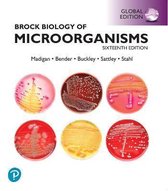GENERAL INTRODUCTION – I – Exploring the microbial world.
1.1 – Microorganisms, Tiny Titans of the Earth.
Microbiology – the study of the dominant form of life on Earth, and the effect that microbes
have on our planet and all of the living things that call it home.
Microorganisms/microbes – life forms too small to be seen by a naked human eye, these
microscopic organisms differ in form and function and inhabit every environment on the Earth
that supports life.
- Many microbes are undifferentiated single-celled organisms, some form complex
structures, and some are multicellular.
- Typically live in complex microbial communities and their activities are regulated by
interactions with each other, their environments and other organisms.
- Teeming on the land and in the seas for billions of years before the appearance of plants
and animals, and their diversity is staggering. Therefore, they represent a major fraction
of Earth’s biomass and their activities are essential to sustaining life. The evolution and
survival of plants are influenced by microbial activities, symbioses and pathogens (the
microbes that cause disease).
● Microbial culture – a collection of cells that have been grown in or on a nutrient medium.
● Medium – is a liquid or solid nutrient mixture that contains all of the nutrients required
for a microorganism to grow.
● Growth – the increase in cell number as a result of cell division.
● Colony – when a single microbial cell placed on a solid nutrient medium grows and
divides into millions or billions of cells.
The formation of such colonies makes it easier to distinguish and grow microorganisms. The
ability to grow microorganisms rapidly under controlled conditions makes them highly useful for
experiments that probe the fundamental processes of life.
1.2 – Structure and Activities of Microbial Cells.
Elements of Microbial Structure:
All cells have a permeability barrier called the cytoplasmic membrane that separates the inside of
the cell, the cytoplasm, from the outside.
● Cytoplasm – is an aqueous mixture of macromolecules (proteins, lipids, nucleic acids,
polysaccharides, etc.), small organic molecules (precursors of macromolecules), various
inorganic ions, and ribosomes.
● Ribosomes – the structures responsible for protein synthesis.
, ● Cell wall – relatively permeable structure located outside the cytoplasmic membrane and
is a much stronger layer than the membrane itself, it lends the cell its structural strength.
Typically in plant cells and most microorganisms but not in animal cells.
Two fundamental cell types that differ in cellular organization: prokaryotic and eukaryotic.
- Cells that have eukaryotic cell structure are found in the Eukarya group of organisms.
This group includes plants and animals, as well as diverse microbial cells such as algae,
protozoa, and fungi. They contain an assortment of membrane-enclosed cytoplasmic
structures – organelles. They include the DNA-containing nucleus but also mitochondria
and chloroplasts, organelles that specialize in supplying the cell with energy, and various
other organelles.
- Prokaryotic cell structure is found within two different groups of organisms – Bacteria
and Archaea. These cells have a few internal structures, lack a nucleus and lack
organelles. Bacteria and Archaea appeared long before the evolution of eukaryotes.
Genes, Genomes, Nucleus, and Nucleoid:
● Genome – is the full set of genes in a cell. It is the living blueprint of an organism.
● Gene – a segment of DNA that encodes a protein or an RNA molecule.
● Chromosomes – genomes of prokaryotic and eukaryotic cells are organized into these
structures.
○ In eukaryotes, the DNA is present as several linear molecules within the
membrane-enclosed nucleus.
○ In prokaryotes, the genomes are closed circular chromosomes (some cells have
linear chromosomes).
● Nucleoid – a mass that is visible in the electron microscope which is not enclosed by a
membrane and it is formed when the chromosome aggregates within the prokaryotic cell.
● Plasmid – while most prokaryotes have a single chromosome, many contain small circles
of DNA distinct from that of the chromosome. Plasmids contain genes that are not
essential but often confer some special property on the cell (such as a unique metabolism.
Or antibiotic resistance).
○ The genomes of B&A (bacteria and archaea) are small and compact, containing
500-10000 genes encoded by 0.5-10 million base pairs of DNA.
○ Eukaryotes have much larger and much less streamlined genomes. A human cell
contains approximately 3 billion bp, which encodes 20000-25000 genes.
,Activities of Microbial Cells:
All cells show some form of metabolism through which nutrients are acquired from the
environment and transformed into new cellular materials and waste products. During these
transformations, energy is used to support synthesis of new structures which culminates in the
cell division and support growth of the microbes. Genes contain information that is used to carry
out metabolic processes, they are decoded to form proteins that regulate these processes.
Enzymes – the proteins that have catalytic activity, carry out reactions that supply energy and
perform biosynthesis within the cell. Along with other proteins, enzymes are synthesized during
gene expression in the processes of transcription and translation.
● Transcription – the process by which the information encoded in DNA sequences is
copied into an RNA molecule.
● Translation – the process whereby the information in an RNA molecule is used by a
ribosome to synthesize a protein.
● DNA replication – replication of the genome that is required for microbial growth,
followed by cell division.
Some microbial cells are capable of motility by self-propulsion. Motility allows cells to relocate
in response to environmental conditions. Some microbes undergo differentiation that results in
the formation of specialized cells for growth, dispersal or survival. Microbes exhibit
intercellular communication – they are aware of their neighbors and respond accordingly.
Many prokaryotes exchange genes with their neighbors via horizontal gene transfer.
, Evolution – when genes in a population of cells change in sequence and frequency over time
which leads to descent with modification. It is a rapid process compared to those of plants and
animals, for example, the use of antibiotics in human and vet medicine has selected for the
proliferation of antibiotic resistance in pathogenic bacteria. This rapid evolution leads to
microorganisms growing quickly and acquiring new genes through horizontal gene transfer.
1.3 – Cell Size and Morphology.
Morphology – cell size and shape. Cell shape is useful for distinguishing different microbial
cells and often has ecological significance. The very small size of microbes has an effect on their
ecology and dictates aspects of their biology.
The Small World:
1 µm (micron, micrometer) – is one-millionth of a meter in length. Most prokaryotes are 0.5-10
µm, while eukaryotes are 5-100 µm in length. The smallest eukaryote is 0.8 µm in diameter and
the largest is many centimeters in length. The largest prokaryote is 600 µm long which can be
visible to the human eye. The bacterium Epulopiscium fishelsoni which is found in the gut of the
surgeonfish, can be more than 75 µm wide and 600 µm long. One of the traits that allows this
size of it is that it can have more than 10000 copies of its genome distributed throughout its
cytoplasm, thereby preventing diffusional limitation between the genome and any region of the
cytoplasm. Some other large cells (750 µm) have a large vacuole that fills the center of the cells,
therefore this allows for its large size.





